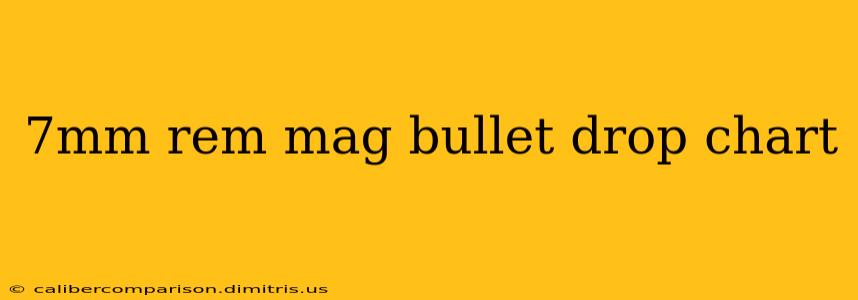The 7mm Remington Magnum is a popular choice for long-range shooting, renowned for its flat trajectory and hard-hitting power. However, understanding bullet drop is crucial for accurate shots at extended distances. This comprehensive guide will delve into 7mm Rem Mag bullet drop, exploring the factors influencing it and providing insights into creating your own personalized charts.
Understanding Bullet Drop
Bullet drop is the vertical distance a bullet falls below its initial trajectory due to gravity. Several factors significantly affect this drop:
-
Bullet Weight: Heavier bullets generally experience less drop due to their higher momentum. A 160-grain bullet will drop less than a 140-grain bullet at the same velocity.
-
Muzzle Velocity: Higher muzzle velocity translates to a flatter trajectory and reduced bullet drop. A hotter load will result in less drop than a milder one.
-
Ballistic Coefficient (BC): This measures a bullet's ability to overcome air resistance. Higher BC bullets retain velocity better, leading to less drop. This is influenced by the bullet's shape and construction.
-
Altitude and Barometric Pressure: Higher altitudes and lower barometric pressure result in thinner air, leading to less air resistance and slightly less bullet drop. However, the effect is generally minimal at common hunting and shooting ranges.
-
Temperature: Air density changes with temperature. Warmer air is less dense, resulting in slightly less bullet drop. Again, this effect is usually minor within typical shooting conditions.
-
Wind: Wind is perhaps the most significant factor affecting bullet trajectory beyond bullet drop. Crosswinds deflect the bullet horizontally, while headwinds and tailwinds affect both horizontal and vertical trajectory.
Creating Your Own 7mm Rem Mag Bullet Drop Chart
Generic bullet drop charts offer a general guideline, but a personalized chart provides superior accuracy. To create your own, you'll need:
1. Ballistic Calculator:
Numerous online ballistic calculators and software programs are available. These programs utilize the factors listed above to calculate precise bullet drop data for your specific ammunition and rifle setup. Popular options include:
- Strelok Pro: A versatile and highly regarded ballistic app.
- JBM Ballistics: A widely used online ballistic calculator.
- Point Blank Solutions: Offers various ballistic software options.
2. Accurate Input Data:
Accurate data is crucial for reliable results. You need the following information:
-
Ammunition Specifications: Bullet weight, ballistic coefficient (BC), and muzzle velocity. These are typically found on the ammunition box or manufacturer's website. Consider using measured muzzle velocity from a chronograph for the highest accuracy.
-
Rifle Information: Barrel length and twist rate.
-
Environmental Conditions: Altitude, temperature, and barometric pressure at your shooting location. This data can often be found through weather apps or online resources.
3. Testing and Refinement:
While ballistic calculators provide accurate predictions, real-world testing is essential. Shoot at various distances, noting your impacts. Compare your results to the calculated data, adjusting your input parameters as needed to fine-tune your predictions.
Using Your Bullet Drop Chart
Once you have a personalized bullet drop chart, remember to always consider wind conditions. A strong crosswind can significantly affect your shot placement. Practice makes perfect, so spend time at the range to familiarize yourself with your rifle and ammunition's performance.
Disclaimer:
Always prioritize safety when handling firearms. Ensure you understand proper firearm safety procedures and follow all applicable laws and regulations. This information is for educational purposes only and should not be considered a substitute for professional training.

